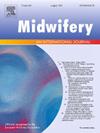尿失禁与产后体力活动的关系:一项横断面研究
IF 2.6
3区 医学
Q1 NURSING
引用次数: 0
摘要
产后妇女在很大程度上活动不足,因此面临许多不良健康后果的风险。《2018年身体活动指南》建议产后妇女进行中度至剧烈的身体活动(MVPA)和肌肉强化运动(MSE),以促进整体健康并降低患慢性病的风险。尿失禁(UI)在一般人群中是身体活动的障碍,但产后妇女在以前的研究中没有被代表。研究目的探讨产后尿失检及其特征(是否存在、严重程度、类型和困扰)与产后MVPA和MSE的关系。方法本横断面研究采用电子自我报告问卷来评估UI、身体活动和人口统计学特征。多元逻辑回归评估符合或不符合产后身体活动指南的几率。多元线性回归评估UI特征与MVPA和MSE的周分钟数的关联。结果244名产后妇女(32.9±4.4年)中近三分之二(64%)患有尿失禁。没有UI特征与满足或不满足身体活动指南相关。然而,更严重的UI和混合型UI与更低的每周MVPA分钟相关。混合型和未定义型UI与较低的MSE周分钟相关。患有严重、混合性或不明性尿失禁的产后妇女可能有更大的低体力活动和相关健康后果的风险。建议使用纵向研究设计和更多样化的人群进行进一步的研究来证实这种关联。结论产后妇女应进行尿失禁筛查,并向具有尿失禁专业知识的保健人员咨询,并开具产后运动处方。本文章由计算机程序翻译,如有差异,请以英文原文为准。
Associations of urinary incontinence with postpartum physical activity: A cross-sectional study
Problem
Postpartum women are largely insufficiently active and therefore, at risk for many adverse health outcomes.
Background
The 2018 Physical Activity Guidelines recommend postpartum women perform moderate-to-vigorous physical activity (MVPA) and muscle strengthening exercise (MSE) to promote overall health and reduce the risk of chronic diseases. Urinary incontinence (UI) is a barrier to physical activity in the general population, but postpartum women have not been represented in previous studies.
Study Aim
To determine the association of UI and its characteristics (presence, severity, type, and bother) with postpartum MVPA and MSE.
Methods
This cross-sectional study used electronic self-report questionnaires to assess UI, physical activity, and demographic characteristics. Multiple logistic regression assessed odds of meeting or not meeting postpartum physical activity guidelines. Multiple linear regression assessed associations of UI characteristics with weekly minutes of MVPA and MSE.
Findings
Nearly two-thirds (64 %) of 244 postpartum women (32.9 ± 4.4 years) had UI. No UI characteristic was associated with meeting or not meeting physical activity guidelines. Greater UI severity and mixed-type UI were, however, associated with lower weekly minutes of MVPA. Mixed and undefined type UI were associated with lower weekly minutes of MSE.
Discussion
Postpartum women with severe, mixed, or undefined UI may be at greater risk for low physical activity and associated health consequences. Additional research using a longitudinal study design and more diverse populations is recommended to confirm this association.
Conclusion
Postpartum women should be screened for UI and referred to healthcare professionals with expertise in UI and postpartum exercise prescription.
求助全文
通过发布文献求助,成功后即可免费获取论文全文。
去求助
来源期刊

Midwifery
医学-护理
CiteScore
4.50
自引率
7.40%
发文量
221
审稿时长
13.4 weeks
期刊介绍:
Midwifery publishes the latest peer reviewed international research to inform the safety, quality, outcomes and experiences of pregnancy, birth and maternity care for childbearing women, their babies and families. The journal’s publications support midwives and maternity care providers to explore and develop their knowledge, skills and attitudes informed by best available evidence.
Midwifery provides an international, interdisciplinary forum for the publication, dissemination and discussion of advances in evidence, controversies and current research, and promotes continuing education through publication of systematic and other scholarly reviews and updates. Midwifery articles cover the cultural, clinical, psycho-social, sociological, epidemiological, education, managerial, workforce, organizational and technological areas of practice in preconception, maternal and infant care.
The journal welcomes the highest quality scholarly research that employs rigorous methodology. Midwifery is a leading international journal in midwifery and maternal health with a current impact factor of 1.861 (© Thomson Reuters Journal Citation Reports 2016) and employs a double-blind peer review process.
 求助内容:
求助内容: 应助结果提醒方式:
应助结果提醒方式:


